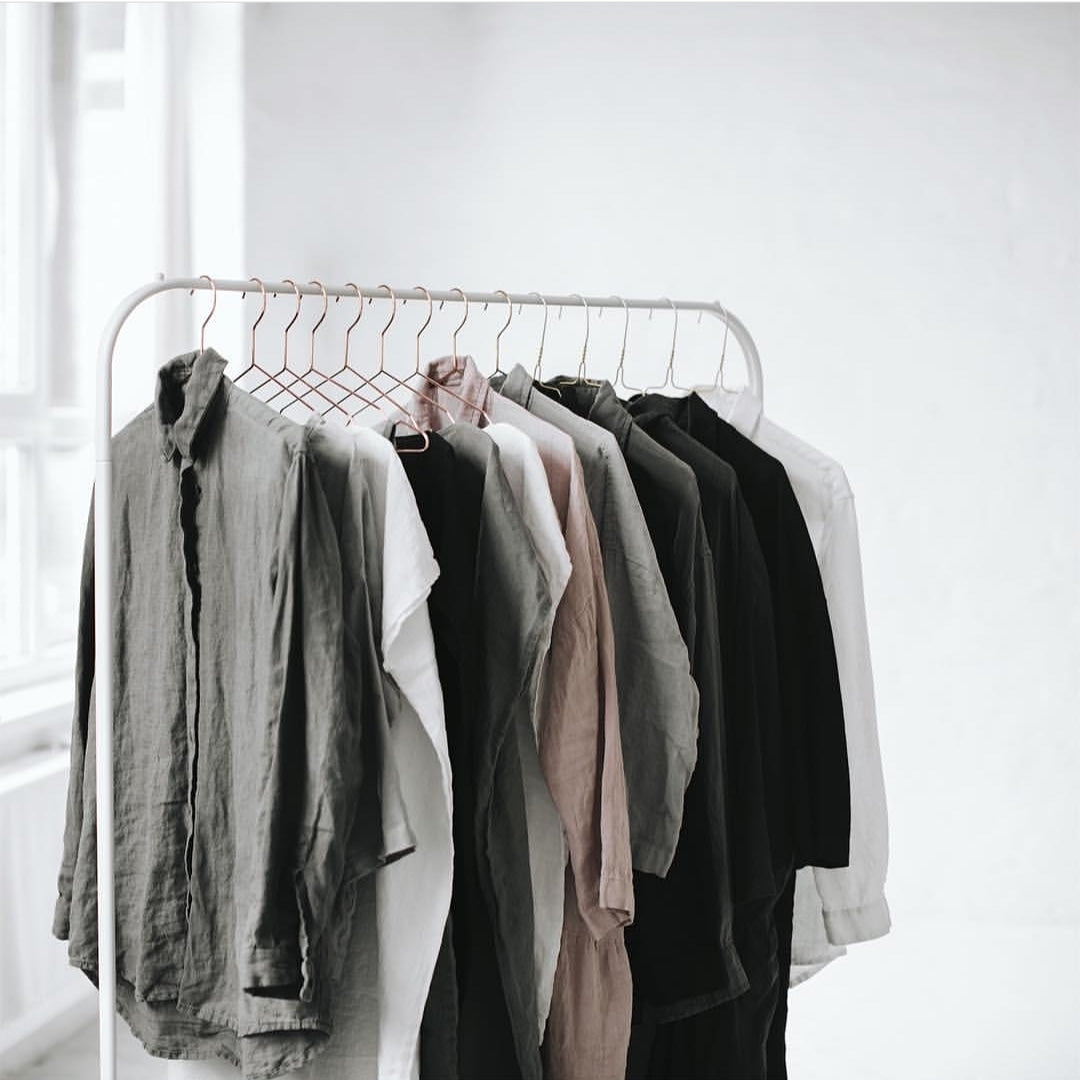Getting the right fit for your bedding all comes down to one thing: knowing your bed's exact dimensions. The easiest way to do this is with a bedding size chart, which quickly matches standard New Zealand bed names, like Queen or King, to their precise measurements.
Your Quick Reference Bedding Size Chart
Let's be honest, navigating the world of bedding can be a bit of a maze, especially with all the different names and subtle variations. This quick lookup chart is here to cut through the confusion and give you a clear, at-a-glance reference for all standard New Zealand mattress sizes.
Think of it as your starting point. Before you even begin looking at new sheets or a duvet cover, a quick check here will ensure you're shopping for the right size. For a deeper dive into the nuances of each size, our comprehensive guide on bed sizes in NZ has all the details you'll need.
Here’s a simple table outlining the standard mattress dimensions you’ll find across New Zealand.
Standard New Zealand Mattress Dimensions
| NZ Size Name | Dimensions (cm) | Dimensions (inches) |
|---|---|---|
| Single | 91 x 190 cm | 36 x 75 in |
| Long Single | 91 x 203 cm | 36 x 80 in |
| King Single | 107 x 203 cm | 42 x 80 in |
| Double | 137 x 190 cm | 54 x 75 in |
| Queen | 152 x 203 cm | 60 x 80 in |
| King | 167 x 203 cm | 66 x 80 in |
| Super King | 183 x 203 cm | 72 x 80 in |
| Californian King | 203 x 203 cm | 80 x 80 in |
Having these exact measurements on hand is the first and most important step towards achieving that perfectly made bed. With this information, you can be confident that the linen you choose will not only look beautiful but fit flawlessly.
How to Measure Your Bed for a Perfect Fit
It's tempting to guess your bed size, but that's often the fast track to ill-fitting sheets and duvet covers. A few moments with a tape measure is the only sure-fire way to use a bedding size chart properly and guarantee your new linens fit like a dream.
First things first, grab a retractable tape measure. For the most accurate dimensions, you'll want to strip the bed completely – yes, that includes any bulky mattress protectors or toppers. We need to measure the mattress itself, without any extra padding throwing off the numbers.
Key Mattress Measurements
Getting the right fit comes down to three simple measurements.
- Width: Stretch your tape measure from the left side of the mattress all the way to the right. Make sure you keep the tape pulled straight and tight to get an exact reading.
- Length: Now, do the same thing from the top of the mattress (where your pillows go) down to the very bottom at the foot of the bed.
- Depth (or Height): This is the one people often forget, but it's absolutely crucial. Measure from the bottom seam of the mattress right up to the top seam. If you always sleep with a plush topper, it's best to include it in this measurement to get the total height.
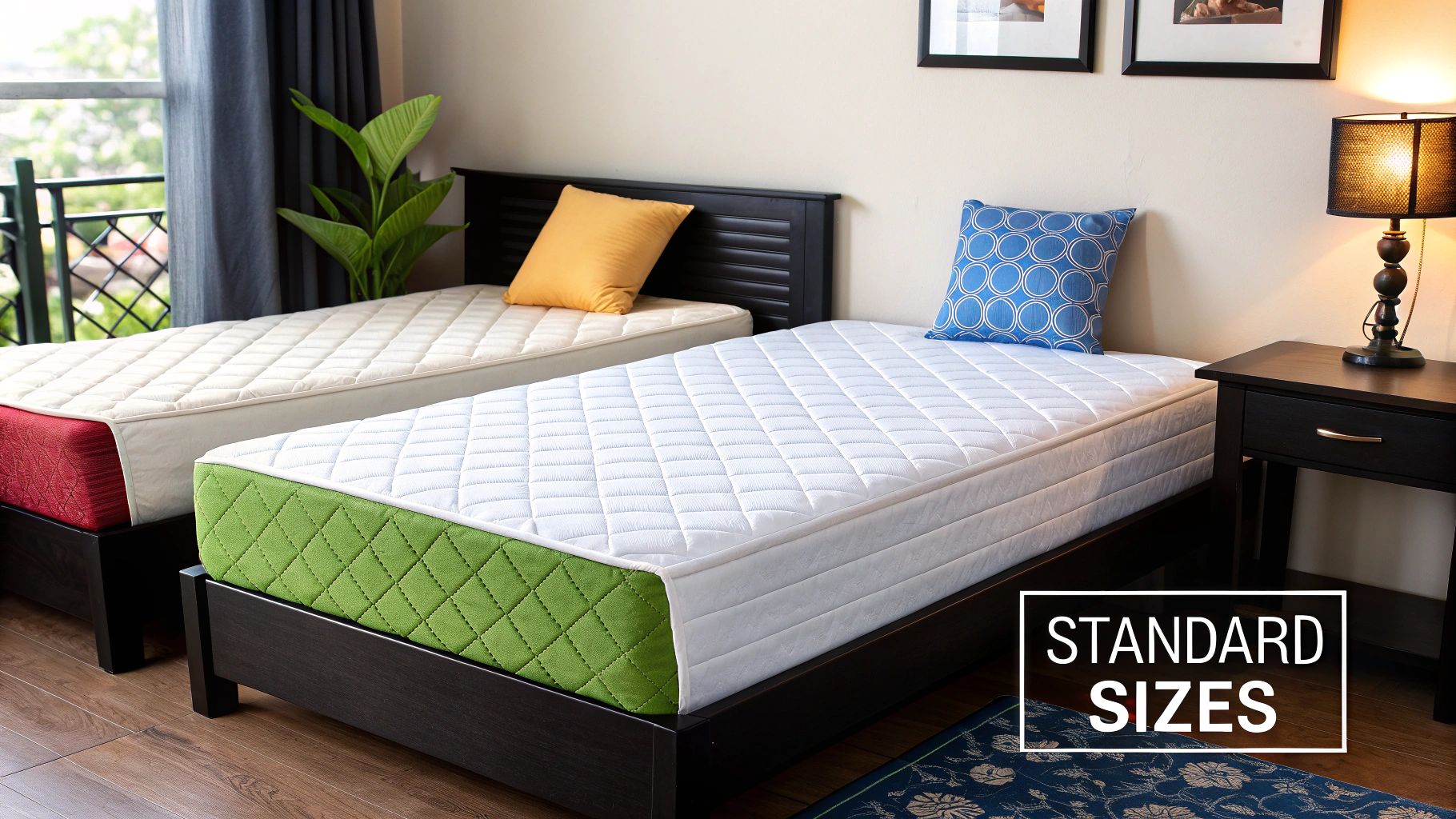
That final depth measurement makes all the difference, especially for your fitted sheets. A standard sheet often won't stretch over a mattress deeper than 35cm, which is what causes those annoying corners to constantly pop off. Knowing your mattress depth means you can look for deep-pocket sheets that will hug your bed securely.
It’s a simple principle: accurate measurements lead to a perfect fit, whether it's for your bed or even something like jewellery, where you might use a printable ring sizer. With these three figures—width, length, and depth—you're all set to confidently choose luxury linens that feel like they were made just for you.
Navigating International Mattress Sizes
Ever tried buying beautiful linens from an overseas store, only to find yourself utterly confused by the sizes? You're not alone. It's a common trap to assume a "King" bed here in New Zealand is the same as a "King" in the United States, but this can lead to some expensive and frustrating mistakes with ill-fitting sheets.
This global size puzzle exists simply because there’s no universal rulebook for making mattresses. Each region—be it the US, the UK, Europe, or here in Australasia—developed its own standards over time, shaped by local tastes and what was considered 'normal' for room sizes. You'll often find American beds are wider, for instance, while UK and European mattresses can have more variation in their lengths.
Key Regional Differences
The best piece of advice I can give you is this: ignore the name on the label. Whether it says "Queen," "King," or "Super King," the only thing that truly matters are the measurements in the product description. Always focus on the numbers.
The image below gives you a stark visual of just how much these sizes can differ, even within one country.
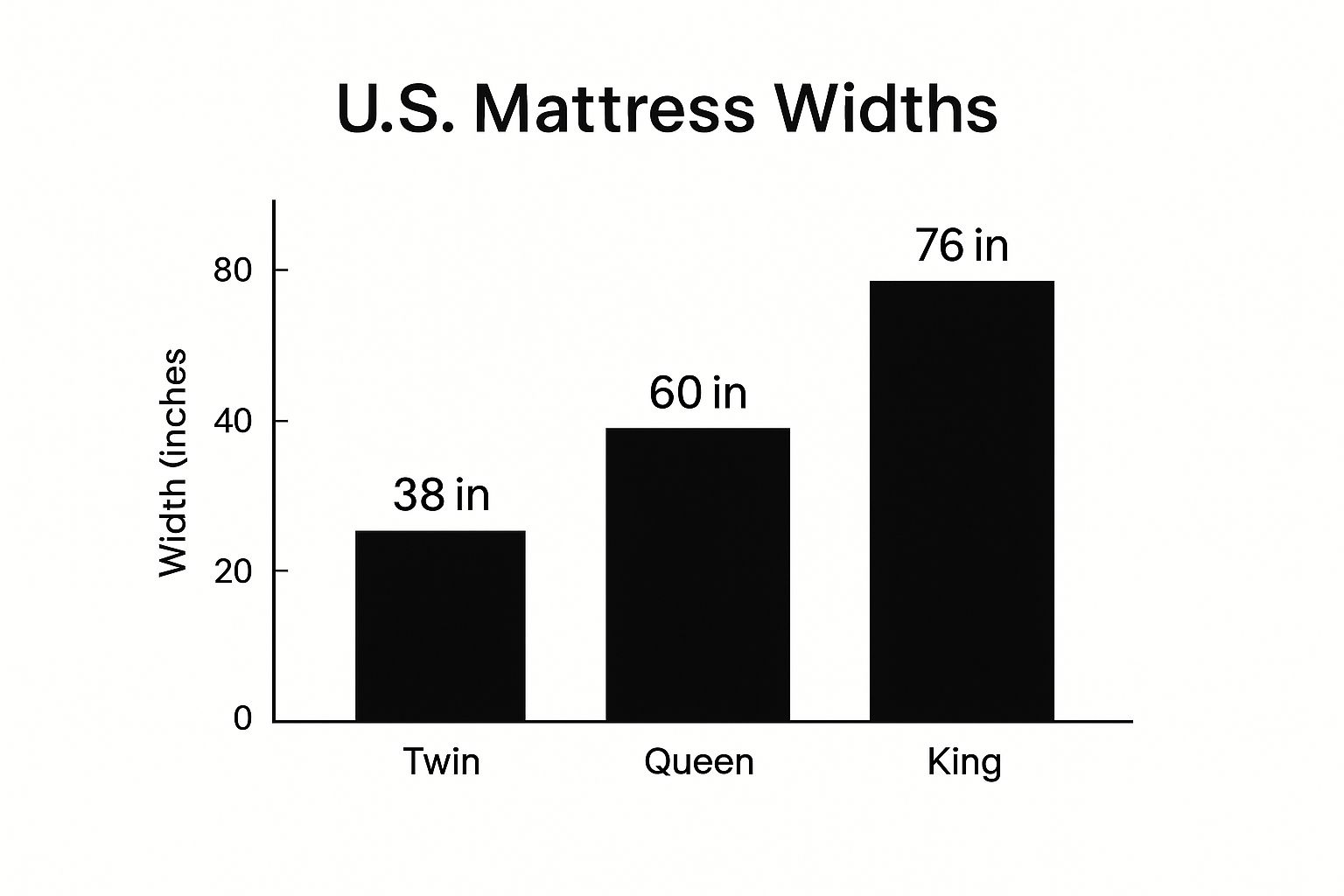
Look at that difference. The gap between a US Twin and a US King is nearly a full metre. It perfectly illustrates why you can't rely on the name alone when you're comparing bedding from different parts of the world.
These regional sizes are deeply woven into local markets. Here in New Zealand, the furniture and floor covering wholesale industry is a big business, valued at around NZ$1 billion, and it's built around what Kiwis want and need for their homes. Because our market isn't heavily skewed by import tariffs, the sizes you find in local stores are genuinely tailored for us. If you're interested in the data, you can find more details on New Zealand's furniture market dynamics on the IBISWorld website.
A Comparative Look at Global Sizes
When you're browsing an international brand's bedding size chart, the names might seem familiar, but the dimensions will tell the real story.
- King Size Confusion: A NZ King is 167cm wide. A US King, however, is a much more expansive 193cm wide. Our NZ Super King at 183cm is a closer cousin to the US King, but it’s still not a perfect match.
- Australian Connection: Thankfully, things are much simpler across the Tasman. New Zealand and Australia share the exact same mattress standards, so shopping from Aussie retailers is completely straightforward. A Queen in Auckland is the same size as a Queen in Sydney.
- European Variations: The EU tends to favour nice, round numbers for their mattress dimensions (like 160 x 200 cm), which rarely align neatly with NZ, UK, or US sizes.
Pro Tip: Before you even start browsing online, measure your mattress. Write down its width, length, and depth in both centimetres and inches. Having these numbers on hand is the single most important thing you can do. It removes all the guesswork and ensures you buy the right size, no matter what it's called.
International Mattress Dimensions (NZ, AU, UK, EU, US)
To make things a bit easier, I've put together a handy comparison table. Think of it as your cheat sheet for navigating the world of bedding. It breaks down the standard mattress sizes across the main regions so you can see exactly how they stack up.
| Standard Size | NZ/AU Dimensions (cm) | UK Dimensions (cm) | EU Dimensions (cm) | US Dimensions (inches) |
|---|---|---|---|---|
| Single | 91 x 190 | 90 x 190 | 90 x 200 | 38 x 75 (Twin) |
| King Single | 107 x 203 | N/A | N/A | 38 x 80 (Twin XL) |
| Double | 137 x 190 | 135 x 190 | 140 x 200 | 54 x 75 |
| Queen | 153 x 203 | 150 x 200 (King) | 160 x 200 | 60 x 80 |
| King | 167 x 203 | 180 x 200 (Super King) | 180 x 200 | 76 x 80 |
| Super King | 183 x 203 | N/A | 200 x 200 | 72 x 84 (Cal King) |
| California King | 203 x 203 | N/A | N/A | N/A |
Use this as your go-to reference when you're looking at international brands. It’ll help you make sure that whatever you buy will be a perfect fit for your bed back home. And don't forget to check the mattress depth, too – it’s just as critical for getting fitted sheets that don't pop off at the corners
Getting the Right Fit for Your Duvet and Sheets
Picking out the right duvet and sheets isn't as simple as just matching the size name on the label to your bed. To get that perfect look and feel, you need to think about things like duvet drape and the depth of your fitted sheets. A good bedding size chart is your starting point, but a few expert tricks will make all the difference.
Here’s a tip many people swear by: go one size up for your duvet. If you have a Queen bed, try a King duvet. This gives you a generous overhang, or 'drape', that not only looks incredibly luxurious but also puts an end to any nightly battles for the covers. It’s a simple change that instantly makes your bed look more inviting.
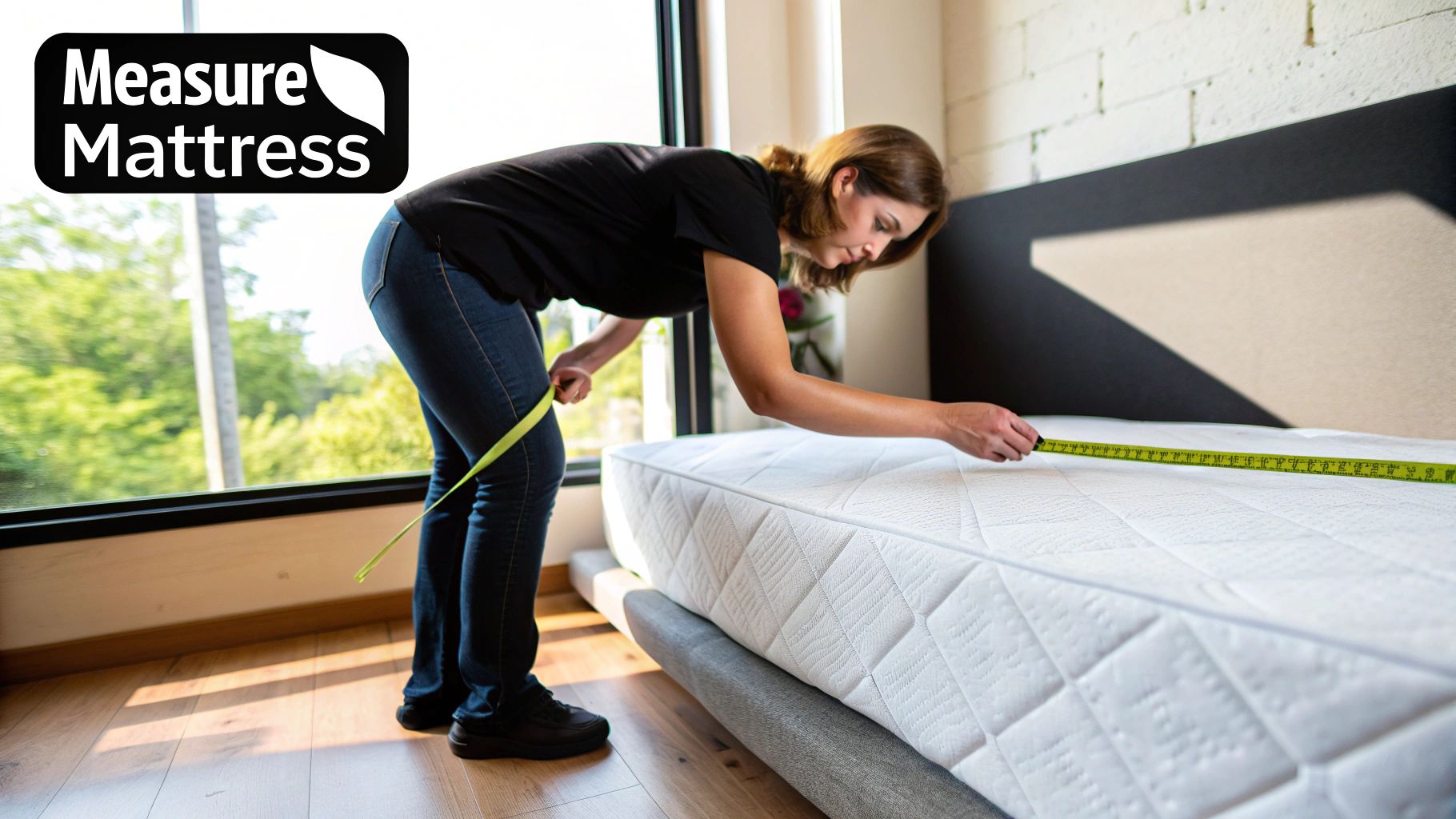
This approach guarantees you’ll stay warm and completely covered all night long. If you want to dive deeper into the specific measurements and styling options, have a look at our complete guide to duvet cover sizes in NZ, which breaks everything down for you.
Don't Forget Fitted Sheet Depth
With flat sheets, the dimensions are pretty straightforward. For fitted sheets, however, the single most important measurement is the pocket depth. This is what determines whether the sheet will hug your mattress corners tightly or annoyingly pop off in the middle of the night.
Standard fitted sheets are generally made to fit mattresses up to 35cm deep. But these days, with so many of us adding plush pillow tops and thick mattress toppers, it's easy to exceed that depth. If your mattress is on the taller side, you’ll need to seek out sheets specifically marked as 'deep pocket' or 'extra deep'.
Getting the right fit is easy if you follow these steps:
- Measure your mattress height. Make sure to include any toppers or protectors you use.
- Add a little extra. For a really secure fit that tucks well under the mattress, look for a pocket depth that’s at least 5-7cm deeper than your mattress height.
- Check the product details. Always double-check the pocket depth in the product description before you buy.
Choosing the Best Bed Linen
Once you've sorted the sizing, the next step is considering the material and quality, which truly shapes your sleep experience. The bed linen market is always changing, and right now, there's a clear move towards valuing quality and items that last.
As of 2024, the bed linen market in New Zealand actually saw a noticeable contraction after its peak in 2021. This points to a shift in how we shop – people are becoming more deliberate, choosing to invest in durable, high-quality materials rather than fast-fashion-style bedding.
Key Takeaway: For a bed that looks as good as it feels, a few details are crucial. Sizing up your duvet creates a luxurious drape, while accurately measuring your mattress depth ensures your fitted sheet stays put. Getting these basics right is the secret to creating a beautiful and comfortable sanctuary for sleep.
A Guide to Pillow and Pillowcase Dimensions
Getting your pillows right is just as crucial as choosing the perfect sheets or duvet when it comes to creating a truly comfortable and well-styled bed. While our main bedding size chart covers the essentials for mattresses and duvets, knowing your pillow dimensions is the finishing touch. Here in New Zealand, we have a few standard pillow sizes, and each has its own place on the bed.
A beautifully made bed often comes down to layering different types of pillows. For instance, a Queen bed looks fantastic and perfectly balanced with two Queen pillows for sleeping, with a couple of decorative European pillows sitting squarely behind them. It’s a simple trick that adds depth and gives your bedroom that polished, hotel-luxury feel.
Common New Zealand Pillow Sizes
Working out which pillow you need is easy once you get a handle on the basics. Each size is designed for a specific job, whether it’s for a good night's sleep or just adding that final decorative flair.
-
Standard Pillow (48 x 73 cm): This is the one you’ll see most often. It’s the perfect size for Single and Double beds, and two of them fit snugly across a Queen mattress.
-
Queen Pillow (50 x 80 cm): A little longer than a Standard, the Queen pillow was designed so two of them fit perfectly across a Queen bed. This means no more annoying gap in the middle.
-
King Pillow (50 x 90 cm): These extra-long pillows are made for King and Super King beds. Two of them will span the entire width of the mattress, giving you plenty of support and a really seamless, expansive look.
-
European Pillow (65 x 65 cm): You might know this one as a Euro pillow. It’s a large, square cushion used purely for decoration. They look best propped up against the headboard, sitting behind your sleeping pillows to add height and a touch of elegance. For a bit more inspiration, have a look at our detailed guide on styling with European pillow cases.
Matching Pillowcases for a Perfect Fit
Choosing the right pillowcase couldn't be simpler—just match the name. A Standard pillow gets a Standard pillowcase, a Queen pillow gets a Queen case, and so on.
Important Tip: It really does pay to use the correctly sized pillowcase. If you try to squeeze a pillow into a case that’s too small, you'll compress the filling, which makes it feel firm and lumpy. On the flip side, a pillowcase that’s too big will just look saggy and untidy, undoing all the effort you put into making a beautiful bed.
Getting to Grips with Modern Bedding Trends
Picking the right size from a bedding size chart is a great starting point, but these days, the choices go well beyond just measurements. Here in New Zealand, modern bedding trends are all about personal wellness, sustainability, and turning your bedroom into a genuine sanctuary for rest. Shoppers are now actively seeking out materials and technologies that contribute to better health.
This change has led to a real surge in demand for eco-friendly and natural fibres. You see materials like breathable European linen and ethically sourced wool becoming incredibly popular, prized for their ability to regulate temperature and for their sustainable origins. It's all part of a bigger move towards healthier living and shrinking our environmental footprint.
The Rise of Wellness-Focused Bedding
It's not just about the fabric, either. Hypoallergenic options are now pretty much a standard expectation for a lot of people. Keeping the sleep space clean and healthy is a top priority, which is why there's so much interest in materials that naturally resist dust mites and other allergens. And on that note, to ensure your bed is a truly comfortable and healthy space, it's wise to be aware of any potential pests; understanding common types of bugs in beds can be a good first step.
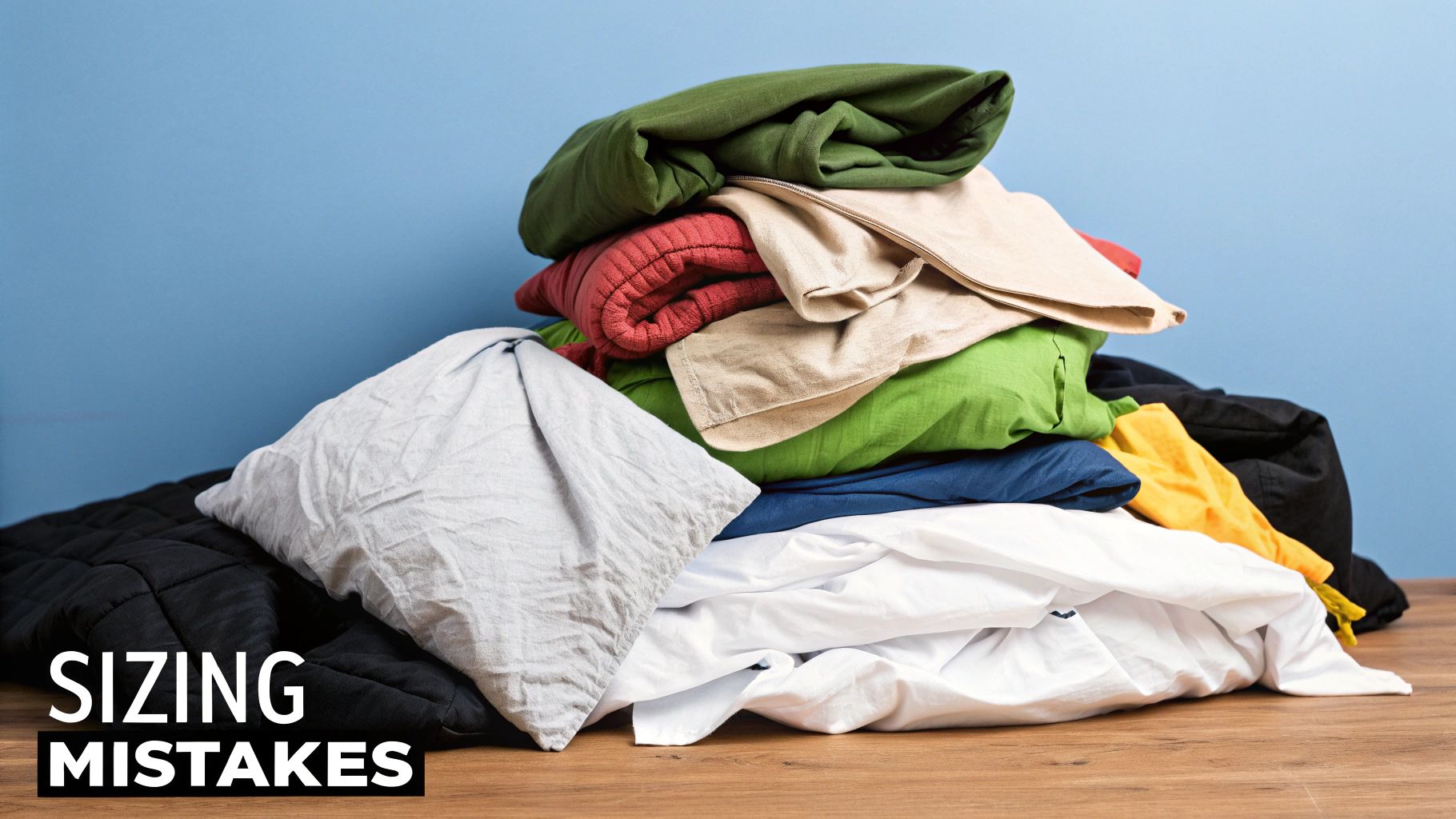
On top of that, sleep technology isn't just a niche gimmick anymore. Bedding with clever features for ergonomic support or advanced temperature control is gaining real momentum as we all look for personalised ways to get a deeper, more comfortable night's sleep.
The market numbers back this up. The home bedding market in New Zealand is forecast to grow steadily, with a compound annual growth rate of around 6.4% from 2025 right through to 2035. What's driving this? Mostly, it's the increased demand for products that improve comfort, sleep hygiene, and sustainability.
Ultimately, choosing the right bedding has evolved into a much more thoughtful decision. It’s now a balance where size, material, and wellness benefits all play an equally important role in creating the perfect place to rest and recharge.
A Few Common Questions About Bedding Sizes
Even with a chart in hand, picking the right bedding can bring up a few tricky questions. Let's clear up some of the most common points of confusion so you can buy your next set of sheets or a new duvet with total confidence.
A question we hear all the time is about shopping across the Tasman. Will Australian sheets fit a New Zealand bed? Yes, they absolutely will. Luckily for us, Australia and New Zealand share the exact same mattress dimensions, so bedding is completely interchangeable. A King in Perth is the same as a King in Queenstown.
Sizing Up and International Differences
Things get a bit more complicated when you look further afield, especially at American sizes. A New Zealand King bed is 167cm wide, but a standard US King is a much wider 193cm. That’s a huge difference, and it means US King sheets will be far too baggy and ill-fitting on a NZ mattress.
So, what about deliberately buying a bigger duvet? This is actually a great idea and a popular trick among stylists. Putting a King duvet on a Queen bed, for instance, gives you that gorgeous, luxurious drape down the sides. It also means no more fighting over the covers at night, and it adds a plush, hotel-like feel to the bedroom.
If your mattress is deeper than 35cm, you'll need to specifically look for fitted sheets labelled as 'deep pocket' or 'extra deep'. Always measure the height of your mattress, including any toppers, to make sure you get a sheet that fits snugly and won't ride up at the corners.
Knowing the answers to these common questions makes shopping for linen so much easier. You can browse local and international stores with a clear idea of what will work, ensuring every piece you choose fits perfectly and looks fantastic.
Discover the perfect fit and exceptional quality with The Foxes Den's collection of luxury European linen and homewares. Explore our curated bedding selections to create your ideal sleep sanctuary.
